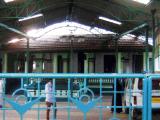It reminds one of the oldest mosque in Kerala in Calicut, maybe even in India – a quiet nondescript house sitting serenely in one of the most crowded areas in Mangalore called Bunder. We had been searching for it and so understated was it that we were directed to two other mosques before we actually found it.

Maybe we should have asked for Jumma Masjid for that is its other name. We went through bustling alleys and streets, most of whom had their own mosques, new ones with domes of different shades of glistening green domes and minarets.
Finally we reached Bunder. The street was lined with shops selling a plethora of goods ranging from groceries to bicycle parts. By sheer happenstance we asked a particular shop owner where this mosque was and he pointed next door to say” It’s here only”. Here? We were surprised as it seemed like just another house.
It is housed a little inside from the road. We were conspicuous by our presence, my friend and I, for there were hardly any women going in or out. A young man in a kurta pajama and white cap came forward and my friend asked if we could take a picture. He agreed instantly and asked if we would like to come inside. But he said, you will have to cover your heads. We agreed and he took us around , very patiently explaining to us its history.
He said that it was a thousand years old; Islam in Kanara dates back to the twelfth century, as it had become the regional center for thriving international trade with Africa and Arabia. There are purportedly letters from Cairo assumed to be from an Abraham Ben Yiju, a North African Jew who settled here for twenty years.
This was unlike the other fellow traders who came and went intermittently, but ultimately went back to their land of origin. These missives are part of the Genizah documents (so called because they were found in the Genizah which is the back room of a synagogue) prove the existence of trade between Africa and Arabia and India. Author Amitav Ghosh researched these scholarly documents for his story in his brilliant novel “In an Antique Land”.
In a similar fashion, Muslim Arab traders had a cordial relationship with the rulers of the western coastal belt of India. This is attested to also by the writing of Ibn Batuta, the intrepid North African traveller who passed through India in 1342 who estimates that the Muslims in this region amounted to 4000.
The Masjid Zaynath Baksh in Bunder is said to have been established in Mangalore in 644 A.D and was inaugurated in February 644 A.D.
In the seventeenth century, Tipu Sultan renovated the mosque adding beautifully carved rosewood pillars and also a carved ceiling. The mosque was renamed after his daughter Zeenat Baksh. The prayer hall is on a plinth with an open colonnade running around the building under heavy overhanging eaves. The renovation coexists in harmony with the older, more ancient structure.
Men were praying with quiet intensity, some standing with stretched hands and some were sitting and praying. I traced the curlicues in the carved ornamentation of the pillars, standing solid and reassuring.
There is a pellucid ablution pool at the back and around the building is a cemetery.The façade of the mosque has green pillars supporting it.
Overall it gives the appearance of a dignified house of worship, providing a sacred sanctuary for both the dead and the living.
Maya Jayapal
source: http://www.deccanherald.com / Deccan Herald / Home> Supplements> Spectrum / by Maya Jayapal / February 25th, 2014








